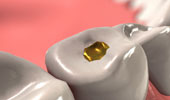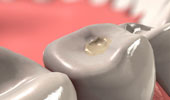Inlays and Onlays

Inlays are similar to fillings but the entire work lies within the cusps (bumps) on the chewing surface of the tooth. Onlays are more extensive than inlays, covering one or more cusps. Onlays are sometimes called partial crowns. Overlays extends outwards from onlays.
Inlays, onlays and overlays are normally done to repair damaged portion of teeth that may be too large to be fixed with composite resin fillings whilst the damage is not overly extensive requiring a dental crown.
Benefits of Dental Inlays and Dental Onlays:
- Increase the strength of a tooth with respect to fillings
- Alternative to an crown when teeth damage is not extensive
- Porcelain inlays/onlays does not change color over time
- Gives better esthetic appearance compared amalgam fillings
Types of Dental Inlays and Dental Onlays


Inlays and onlays can be made of porcelain, gold, or glass ionomer. Porcelain inlays mimic enamel's translucency and color, making them attractive choices for patients. Gold alloy inlays and onlays possess greater durability.
Procedure for Dental Inlays and Dental Onlays Treatment
The course of treatment described here is one of several options available at our dental clinic. Consult your dentist to find out what the best solution is for you, given your specific condition.
- First evaluation and inlays/onlays tooth preparation
- The natural tooth is reshaped to receive the new inlay/ onlay
- Records are taken to determine the color, ength and shape of the inlay/onlay
- An impression of the teeth is taken for a replica model of teeth
- This model is sent to a lab where the inlay and onlay piece is fabricated
- The preparation site is temprorarily covered
- Fitting of the inlay/onlay on delivery
- The temporary filling is removed
- The inlay/onlay is fitted and cemented into place on the teeth
- A quality assurance check is done for any re-adjustments or re-works of the inlay/onlay dental crowns
- Care of inlay/onlay
- Brush and floss your teeth as recommended by your dentist or dental hygienist

Damaged Tooth

Inlays Tooth Preparation

Fitting of Inalys

Care of Inalys
Recovery Expectations
Having inlays or onlays is similar to having fillings done but inlays and onlays tends to be better strength and durability than fillings. There should be little or no sensitivity in teeth.
Care for Dental Inlays and Onlays
Simply follow good oral hygiene practices:
- Brush at least twice a day. It is good practice to brush after eating and before bedtime.
- Floss at least once to twice a day.
- Rinse with fluoride rinse before bed. Swish the fluoride rinse vigorously in your mouth for at least one minute. Do not swallow any of the rinse and do not eat or drink anything for 30 minutes
- Be careful about chewing toffees, gum, grainy rolls and tough food in this area
- See your dentist for regular professional check-ups and cleanings
Gold, Ceramic and Glass ionomer Inlays and Onlays

Made of gold alloy (gold mixed with other metals)
Advantages
- Gold doesn't corrode.
- Some people like the gold color better than the silver color of amalgam.
- Gold fillings are durable enough to withstand chewing forces.
Disadvantages
- higher costs
- possiblility of "galvanic shock"if both gold and amalgam fillings are right next to each other

Advantages
- Ceramics are tooth-colored thus good aesthetics.
- Ceramics are more resistant to stains and abrasion than composite resin.
Disadvantages
- Ceramics are more brittle than composite resin.
- A ceramic inlay or onlay needs to be large enough to prevent it from breaking.

Advantages
- Glass ionomer matches the color of the teeth, although it does not always match as well as composite resin.
- In some cases, no drilling is needed to place a glass ionomer filling.
- Glass ionomers release fluoride, which can help protect the tooth from further decay
- Glass ionomer restorations bond (stick) to the tooth, which helps to prevent leakage around the filling and further decay.
Disadvantages
- Traditional glass ionomer is significantly weaker than composite resin.
- Increased treatment time as thin layer needs to be cured, or hardened, with a special bright blue before the next layers is placed





